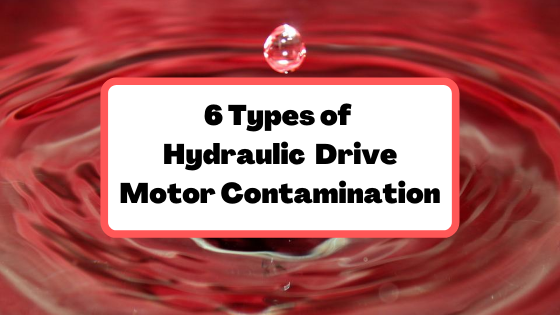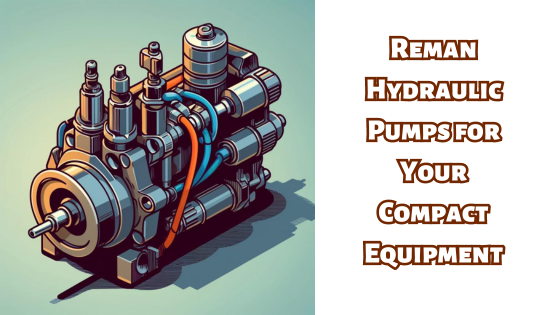6 Types of Hydraulic Drive Motor Contamination
Jul 23rd 2020
There are six types of contamination that can affect the performance of your final drive motors. Do you know what they are?

Hydraulic Contamination - Are Your Drive Motors at Risk?
There are six basic types of hydraulic contamination that can impact the performance and integrity of your final drive motor. Read on to learn what they are and how to prevent them.
Type #1: Built-In Contamination
It might come as a bit of surprise, but even brand new hydraulic equipment is going to have some contamination already represent. This is referred to as built-in contamination and results from the manufacturing, assembly, and repair processes. It can take the form of ...
- A small sliver of metal left over from a drilling or tapping operation
- A single thread from a rag used to wipe down a part or assembly
- A piece of welding slag
- Grains of sand left over from casting processes
- A glob of grease
Because these types of debris aren't mean to be in your final drive motor or pump, they are considered contamination. And as contamination, they can have an adverse effect on performance and can lead to other problems. This is why some experts recommend that you flush your hydraulic system when you install new components or when your machine has undergone an overhaul.
Aside from flushing your hydraulic system, filters are the best way to keep built-in contamination under control.
Type #2: Generated Contamination
As hydraulic pumps and drive motors run, they actually generate contamination. This type of hydraulic contamination results in very final metallic particles that often look like dust. These particles are generated during metal-to-metal contact, specifically during the break-in period for the component and when there is not enough lubrication present to protect the contact surfaces. Over time, as wear increases, the size of the particles can also increase.
Larger particles often take the form of a chip from the surface of a ball within a anti-friction bearing or a chunk of meal that breaks loose from a gear tooth that is transmitting a significant amount of torque.And, even though it might not be metallic, particles from failing rubber seals is also a type of generated contamination.
Given enough time, generated contamination will impact the efficiency and productivity of your hydraulic system as well as components such as motors and pumps. And every bit of metallic contamination is extremely likely to generate even more contamination, resulting in serious cycle of damage. While this type of contamination is unavoidable, it can be mitigated by the proper use of filters and regular maintenance.
Type #3: Chemical Contamination
Another common type of hydraulic contamination is chemical, which usually results from the natural degradation of the hydraulic fluid. Over time, the chemicals that make up hydraulic fluid break will break down into different components, and those components aren’t always good for your hydraulic system. And this breakdown can be drastically sped up when components start overheating.
There is another way that chemical contamination can occur: mixing two different types of hydraulic fluid together. If their additives are not chemically compatible, them chemical reactions can occur that will contaminate the fluid. Finally, remember that even the highest quality hydraulic fluid will eventually degrade and become practically unusable.
The best way to deal with chemical contamination is to avoid mixing different types of fluid together, address issues with overheating, and change your hydraulic fluid out according to manufacturer guidelines.
Type #4: Particulate Contamination
Particles of dust, sand, silica, dirt, cement, and even metal can make their way inside your final drive. Once there, they will wreak havoc and cause critical components to wear out prematurely. The two main ways this type of contamination gets in is through leaking seals and opening up the final drive in a dirty environment. If fluid can get out of your final drive, then particulate contamination can get inside of it. That's why we emphasize regularly checking for leaks and only working on your final drive in a relatively clean environment free of dirt and debris.
Type #5: Water Contamination
Water may not seem as damaging as abrasive particles like metal or sand, but it can cause problems with compressibility, corrosion, sludge, and cavitation. Water keeps the fluid from compressing as it normally would, which can affect not just the performance of your final drive motors but your hydraulic arms as wells. Water in the fluid in cause corrosion to start and inhibits the ability of the hydraulic fluid to act as a lubricant. The presence of moisture in the fluid will lead directly to sludge, which is never good. And cavitation causes serious surface damage in the form of pitting, which is expensive to repair. In addition, all of these lead to a reduction of the efficiency and performance of your final drive motor and your system as a whole.
If you notice your hydraulic fluid looking a bit milky, then you likely have water contamination. This can be prevented by not leaving your hydraulic fluid open and exposed to the atmosphere, and keeping unused fluid in a sealed container.
Type #6: Air Contamination
Air can also contaminate your hydraulic fluid, mainly affecting its compressibility (like we just talked about with water). If enough air gets trapped in your system, you'll start noticing a loss of torque in your drive motors and an increased cycle time for your attachments.
Minimizing air contamination is pretty straightforward and pretty similar to what we just said about water contamination: don’t unnecessarily expose your system to air and don’t leave your hydraulic fluid storage containers open.
Impact of Contamination on Final Drive Motors
Hydraulic contamination is a serious issue for your compact equipment. It can increase cycle time, lead to damage, reduce efficiency, and lead to costly catastrophic failure. The best way to prevent it is to check and change your filters regularly and avoid introducing contamination into your system.







